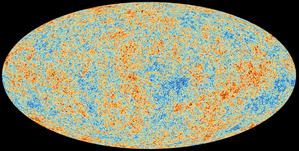Glossary term: 宇宙微波背景輻射(CMB)
Description: 宇宙微波背景(CMB)是宇宙大約 38 萬年前,光與重子解耦自由傳播遺留至今的電磁輻射。它提供了有關宇宙的組成、幾何(形狀)、演變和結構演化的信息。早期的緻密宇宙是由自由粒子(質子、中子、電子)和光(光子)組成的 "熱湯"。在CMB產生之前,光子與自由電子的相互作用阻礙了光的遠距離傳播。宇宙的膨脹和冷卻使自由電子與質子結合形成氫原子,並使光得以在宇宙中傳播。宇宙膨脹隨後拉長了這些光子的波長,使它們如今可以在電磁波譜的微波區域被探測到。
Related Terms:
See this term in other languages
Term and definition status: The original definition of this term in English have been approved by a research astronomer and a teacher The translation of this term and its definition is still awaiting approval
This is an automated transliteration of the simplified Chinese translation of this term
The OAE Multilingual Glossary is a project of the IAU Office of Astronomy for Education (OAE) in collaboration with the IAU Office of Astronomy Outreach (OAO). The terms and definitions were chosen, written and reviewed by a collective effort from the OAE, the OAE Centers and Nodes, the OAE National Astronomy Education Coordinators (NAECs) and other volunteers. You can find a full list of credits here. All glossary terms and their definitions are released under a Creative Commons CC BY-4.0 license and should be credited to "IAU OAE".
If you notice a factual or translation error in this glossary term or definition then please get in touch.
Related Media
宇宙微波背景輻射
Credit: 歐空局/普朗克合作組織 credit link
License: CC-BY-SA-4.0 Creative Commons 姓名標示-相同方式分享 4.0 國際 (CC BY-SA 4.0) icons









